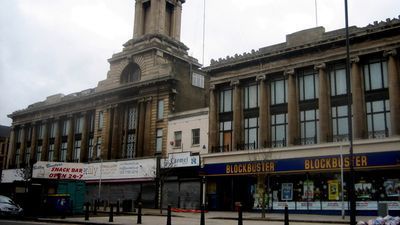Saving Spiegelhalter’s
By DAVID COLLARD
Ian Nairn is regarded by his many admirers as Britain's greatest topographical writer, and Nairn's London (published in 1966 and recently reissued by Penguin Books in an edition reviewed in this week’s TLS) is his masterpiece. It is (Nairn says, modestly, in his introduction) “simply my personal list of the best things in London”. There are around 450 of these, between Uxbridge and Dagenham.
Nairn had astonishing powers of evocation and taught his readers not only how to look at buildings but how to feel about what they saw. He was interested not only in buildings but, as Gavin Stamp points out in his afterword to this edition, in the character of places.
Nairn was also the exemplary outsider. . . .
The architectural establishment was snootily disparaging about his lack of qualifications but he knew more about buildings and their communities than most of the professionals. He became a household name in 1955 at the age of twenty-five with the publication of OUTRAGE, a brilliantly scathing and bilious polemic directed at the post-war planners and architects responsible for what he called “subtopia”, a dreary combination of suburban and utopian tastes that meant the outskirts of Southampton and Carlisle were indistinguishable. Nairn didn't hate modern architecture – just bad architecture, and particularly the heartless perpetrations of property developers and town planners that involved the wholesale demolition of city centres in the 1960s and 70s. An eloquent contrarian, a non-clubbable dissident and anti-establishment to the core, Nairn was a cross (said Jonathan Meades) between Anthony Burgess and Tony Hancock. He died young, aged fifty-two, in 1983, from the effect of chronic alcoholism. We need his glum, incisive voice more than ever.
Which brings us to Spiegelhalter's. It's not much to look at – a tatty shop front on London's Mile End Road a few miles to the east of King's Cross. Now roofless and derelict, it's what's left of a family-run jewellers’ shop, a business founded in 1828 by German migrants. But it is a powerful symbol of East End indomitability, surviving the Depression and Blitz and subsequent economic downturns until finally closing down in the late 1980s. It is fondly remembered by locals who bought their wedding rings or had their ears pierced on the premises, and more widely appreciated by those of us who, like Nairn, know a good joke when we see one because the Spiegelhalter family simply refused to budge or sell out as a construction project for a department store went ahead on either side of their shop, leaving their modest, low-rise establishment sandwiched between two grandiose but hilariously unbalanced frontages. A local legend has it that the store owners, the Wickhams, offered to cover the ground floor of Spiegelhalter's in gold sovereigns if the owners would move out. The owners said they would – if the coins were all balanced on their sides. Nairn wrote about it fondly:
“Messrs Wickham, circa 1920, wanted an emporium. Messrs Spiegelhalter, one infers, wouldn't sell out. Messrs Wickham, one infers further, pressed on regardless, thereby putting their Baroque tower badly out of centre. Messrs Spiegelhalter ('The East End Jewellers') remain; two stucco'd storeys, surrounded on both sides by giant columns à la Selfridges. The result is one of the best visual jokes in London, a perennial triumph for the little man, the blokes who won't conform. May he stay there till the bomb falls.”
It's still there. The bomb has not dropped – yet. For almost a century this plucky little structure has stood its ground, a remarkable survivor. In China such buildings are known as “nails” (as in a stubborn nail embedded in the plank, that cannot be prised out), and it's hard not to share Nairn's sentimental view that they represent a triumph of the individual over bullying property developers, planners and architects. Nairn added this melancholy reflection:
“A bleak thought is that, if Messrs Wickham's problem had arisen today, smooth lawyers and architects would probably have presented a case for comprehensive redevelopment, and persuaded the council to use their powers of compulsory purchase. Big deal; fine democracy.”
Spiegelhalter's is not just a great visual joke but a marvellously evocative record of the area’s complex ethnic mixture and cultural continuities. I've recently launched an online petition to secure the future of this lovable landmark. The campaign is supported by the Twentieth Century Society and has, within a few days, attracted more than one thousand supporters. Anyone interested can add their signature here.
Peter Stothard's Blog
- Peter Stothard's profile
- 30 followers




